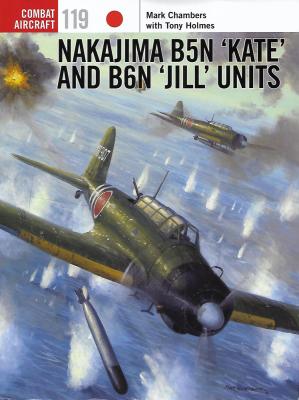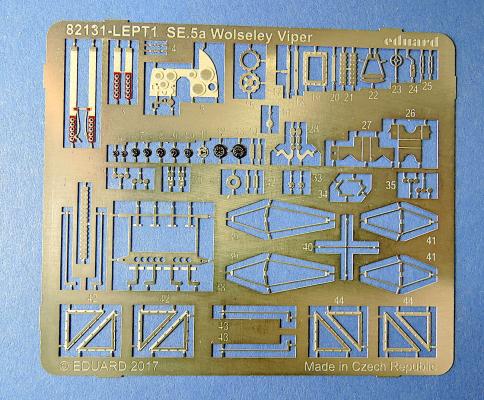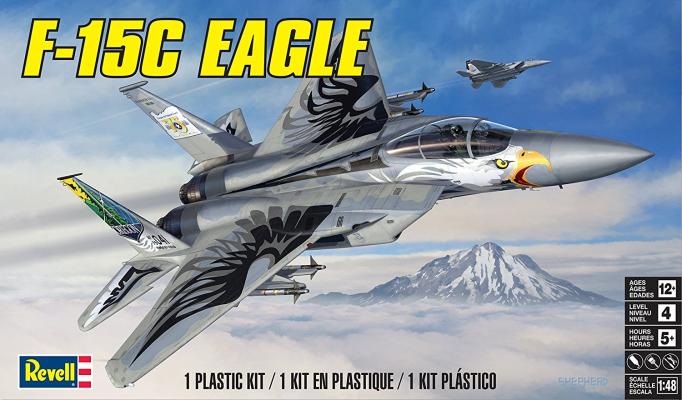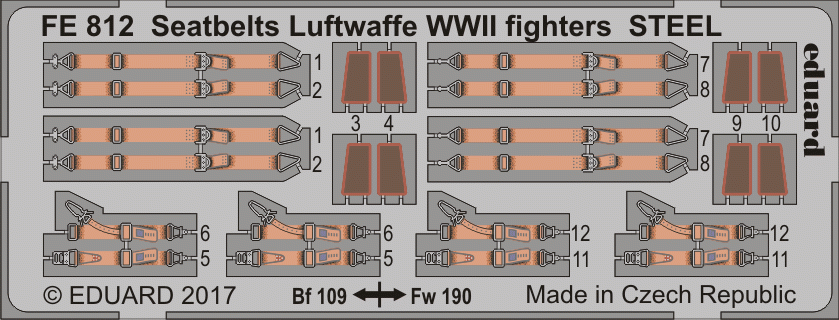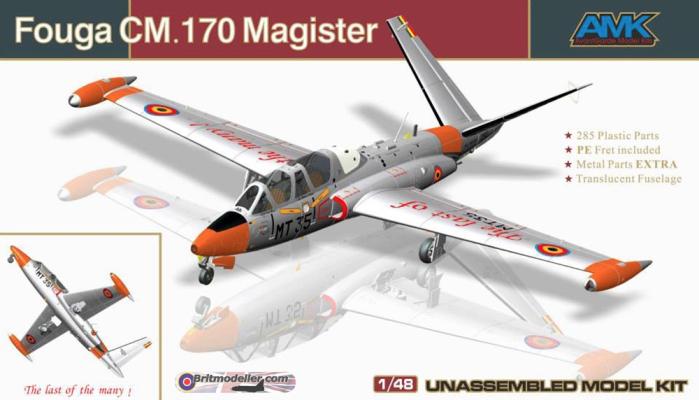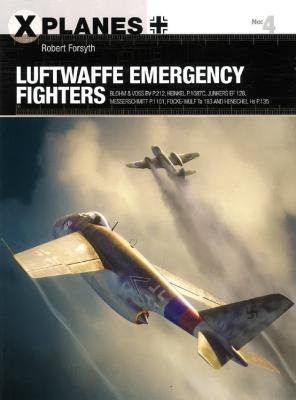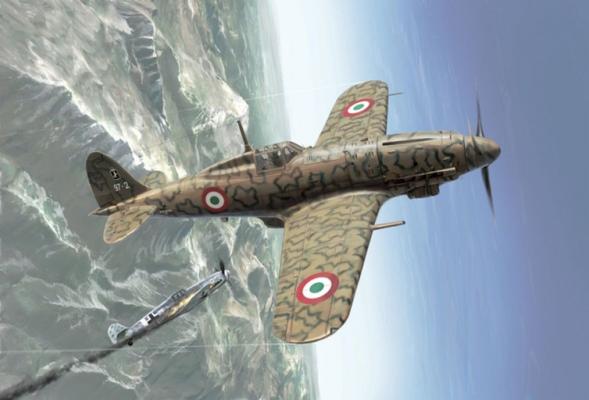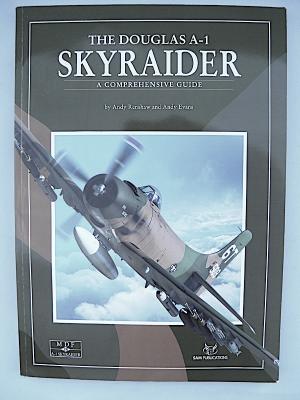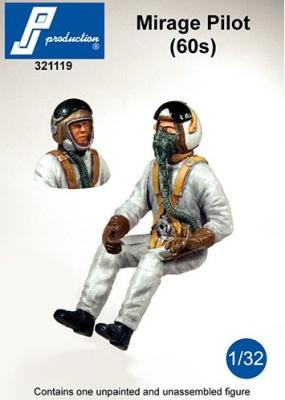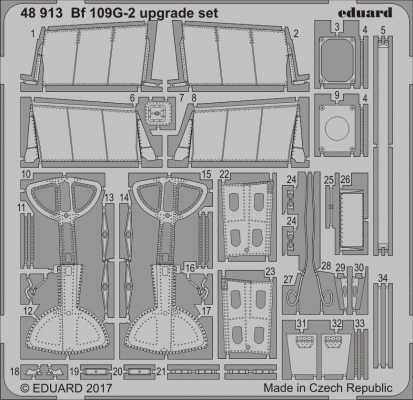The Imperial Japanese Navy entered the Pacific War with the most advanced ship-based attack bomber in the world, flown by the most experienced aircrews of any service. First flown in 1937, and introduced into squadron service during the Sino-Japanese conflict in 1938, the Nakajima B5N was faster, flew farther and carried a heavier payload than either of its British or American contemporaries (principally, the Fairey Swordfish and Douglas TBD Devastator, respectively). When used as either a level bomber against stationary targets, or as a torpedo bomber against ships, the “Kate” (as it came to be known to the Allies) would wreak havoc against Japan’s enemies for the first year of the war.
This is the photoetch fret for Eduard's 1/48 SE.5a. It is listed for the Wolseley Viper Version of the kit, but can also be used for the Hispano-Suiza Version of the SE.5a. This is the same photoetch fret included with Eduard's Wolseley Viper, and with the Royal Class edition as R0015-LEPT 1. It can also be purchased separately from either kit. The photoetch fret is not required for completion of the kits, but adds more accurate scale detail than the kit parts.
The steel fret is about 2-3/4 x 2-1/4 inches and includes photoetch pieces for the seatbelts, instrument panel and gauges, machine gun magazine upgrades, several different cockpit levers, brackets for the exhaust pipes, cables and stanchions for the control surfaces, bomb rack, and frames for the wing pulley observation panels.
IPMS USA appreciates Revell USA sending us this model, and I also give the nod to our leadership within the reviewer corps for forwarding me the kit to review.
A personal note concerning the actual aircraft: To use an Eagle painted on an Eagle, what a great recruiting tool!!! Eye-catching and unique, interesting markings, and even this older version F-15C is still a viable Air Superiority weapon. When I first saw it I was skeptical, but having built this kit, I found the scheme rather well thought-out and not overbearing. Not just another gray airplane.
The one thing that is a visual interest in a cockpit are the seatbelts and shoulder harnesses. Regardless of what type of aircraft the first thing you see when you look inside the cockpit are the seatbelts.
Eduard has been trying to perfect the use of photo etch seatbelts from the very beginning. Their latest efforts are really nice. This fret includes enough seatbelts for FOUR single engine Luftwaffe aircraft. The STEEL seatbelts are very thin and bendable. The fret is .002 thick and realistically pre-painted. The paint is shaded and looks very realistic. I was able to bend them without the paint coming off which can sometimes be an issue with thicker belts.
If there is a downside, it is that the belts are only painted on one side, but depending on how you bend them they won’t be an issue.
The Kit
When you open the Box you find all the sprues nicely individually bagged in resealing bags. Over to the side there is a cardboard cutout that holds a very nice plastic case containing all of the white metal parts. These parts consist of replacement main wing spar, tail spar, landing gear, guns, ammo belts, and a couple other replacement bits. Also included are nose weights. With the sprues they have included a full clear sprue which is just the same as Sprue A so you can do a Skeleton view of the fuselage. Under all of the sprues you find a small fret of Photo Etch for seat belts, air brakes, and landing gear door latches and a very large decal sheet that gives you the option for 5 different markings options:
Robert Forsyth, born in Berkshire, England, has studied the history and operations of the Luftwaffe since his school days. Based in East Sussex with his wife, he runs an aviation and military publishing business full-time. He has written articles for the magazines Aeroplane, Aviation News, FlyPast, and The Aviation Historian, and is a member of the Editorial Board of the latter publication. He is the author of several hardbound books, including: JV 44 – The Galland Circus (1996), Battle over Bavaria – The B-26 versus the German Jets (Classic, 1998), Mistel – German Composite Aircraft and Operations 1942-1945 (Classic, 2001), Messerschmitt Me 264 Amerikabomber (Classic, 2006, with Eddie Creek); He 162 Volksjäger (Classic, 2009, with Eddie Creek); Heinkel He 111 (Crecy, 2014); Junkers Ju 52 (Specialty Press. 2015, with Eddie Creek).
Italeri has released a boxing of the very good 1/48 Hasegawa Mc. 205, which is enhanced by a super decal sheet for 6 different camouflages. Not only that, but the decal sheet includes “smoke rings”! I believe this is the first time that “smoke rings” are included as part of a regular boxing.
Like most airplanes models construction starts with the cockpit and this is no exception. The plastic parts are capable of delivering a convincing “front office” if care is taken during painting. The instrument panel faces are provided as decals and they certainly enhance the look of the panel as the pictures show. I decided to add a set of Eduard Photo-Etch Italian Seatbelts (Steel) to round up the cockpit. It would have been nice to see at least a decal to reproduce the seatbelt.
My first introduction to the Spad was a film strip (yes, I am that old) about an air rescue operation in Vietnam. Besides the Jolly Green Giants and the support Hercules there were these large, single engine prop planes loaded with munitions buzzing in to keep the enemy’s heads down. They used the call sign Sandy and from that point on I was hooked.
PJ Productions from Belgium makes great aftermarket and figures in resin for aircraft modelers in all scales. This set is a resin Mirage Pilot wearing of the 1960's wearing the white suit named "habit de lumière" and the Garneau helmet T312 or the high-altitude helmet EFA T12. The figure is designed to fit either the Mirage IIIC or early IIIE in 1/32nd scale.
Some things are just better in a scale thickness. Eduard has always provided some of the world leading photoetch. The Eduard 109s are some of the best kits out there of this iconic aircraft, but like other manufacturers, they are limited what they can do in plastic.
This fret of photo etch is designed to allow you to do a variety of options to improve your kit. The big things on the fret are the flaps and landing gear doors. Also included on the fret are the oil cooler exhaust, radio compartment, and lots of parts for the landing gear. Both the flaps and the landing gear doors are a very scaled thickness. The flaps will allow you to position your flaps in any position you so desire.
The radio compartment is a very nice addition if you want to open up the panel. It is interesting that this panel is slightly different than the one in the Brassin Radio Compartment set. This particular one has the area for the first aid kit. Which isn’t on the Brassin set.

